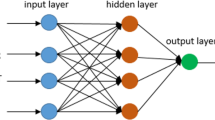Abstract
WSNs consist of small sensor nodes which have limited battery power, limited processing capability and limited memory unit. Self-organization and the lack of infrastructure are regarded as two significant features of WSNs. These features make sensors an appropriate choice and alternative for many applications. Features and limitations of WSNs should be taken into consideration in investigating WSN algorithms and protocols. However, recharging battery in sensor nodes is either impossible or very difficult. The main concern in designing WSN algorithms is to ensure about energy efficiency and lifetime of sensor network. In most cases, a sensor node located in a set of sensor nodes decides that which task should be done and determines the number of unique communication paths among sensor nodes. Large number of lost paths leads to energy imbalance among the nodes. In this paper, using soccer league competition algorithm, we proposed a clustering method which was able to optimize power consumption and reduce delay. The results of simulating the proposed method indicated that it performs better than NODIC protocol.








Similar content being viewed by others
References
Yao, Y., Cao, Q., & Vasilakos, A. V. (2015). EDAL: An energy-efficient, delay-aware, and lifetime-balancing data collection protocol for heterogeneous wireless sensor networks. IEEE/ACM Transactions on Networking (TON),23, 810–823.
Oyman, E. I., & Ersoy, C. (2004). Multiple sink network design problem in large scale wireless sensor networks. In 2004 IEEE international conference on communications, 2004 (pp. 3663–3667).
Hammoudeh, M., & Newman, R. (2015). Adaptive routing in wireless sensor networks: QoS optimisation for enhanced application performance. Information Fusion,22, 3–15.
Zahedi, A., Arghavani, M., Parandin, F., & Arghavani, A. (2018). Energy efficient reservation-based cluster head selection in WSNs. Wireless Personal Communications,100(3), 667–679.
Kulkarni, N., Prasad, N. R., & Prasad, R. (2018). Q-MOHRA: QoS assured multi-objective hybrid routing algorithm for heterogeneous WSN. Wireless Personal Communications,100, 255–266.
Kiran, M., Prasad, Y., & Rajalakshmi, P. (2018). Modeling and analysis of IEEE 802.15.4 multi-hop networks for IoT applications. Wireless Personal Communications,100, 429–448.
Abasıkeleş-Turgut, İ., & Hafif, O. G. (2016). NODIC: A novel distributed clustering routing protocol in WSNs by using a time-sharing approach for CH election. Wireless Networks,22, 1023–1034.
Yadav, K., Pal, V., Singh, G., & Yadav, R. (2012). An efficient load balancing clustering scheme for data centric wireless sensor networks. International Journal of Communication Network and Security (IJCNS),1, 2231–1882.
Raicu, I., Schwiebert, L., Fowler, S., & Gupta, S. K. (2005). Local load balancing for globally efficient routing in wireless sensor networks. International Journal of Distributed Sensor Networks,1, 163–185.
Dai, H., & Han, R. (2003). A node-centric load balancing algorithm for wireless sensor networks. In Global telecommunications conference, 2003. GLOBECOM'03 (pp. 548–552). IEEE.
Mottaghinia, Z., & Ghaffari, A. (2018). Fuzzy logic based distance and energy-aware routing protocol in delay-tolerant mobile sensor networks. Wireless Personal Communications,100(3), 957–976.
Moosavian, N., & Roodsari, B. K. (2014). Soccer league competition algorithm: A novel meta-heuristic algorithm for optimal design of water distribution networks. Swarm and Evolutionary Computation,17, 14–24.
Mahalik, N. P. (2007). Sensor networks and configuration. Berlin: Springer.
Author information
Authors and Affiliations
Corresponding author
Additional information
Publisher's Note
Springer Nature remains neutral with regard to jurisdictional claims in published maps and institutional affiliations.
Rights and permissions
About this article
Cite this article
Ebrahimi, S., Tabatabaei, S. Using Clustering via Soccer League Competition Algorithm for Optimizing Power Consumption in WSNs (Wireless Sensor Networks). Wireless Pers Commun 113, 2387–2402 (2020). https://doi.org/10.1007/s11277-020-07332-z
Published:
Issue Date:
DOI: https://doi.org/10.1007/s11277-020-07332-z




